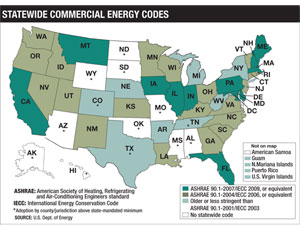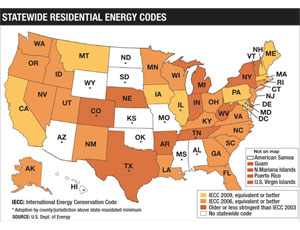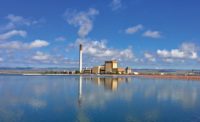The building energy-use reporting tool released this month by the American Institute of Architects may help firms get a handle on how their designs compare to others regarding predicted energy consumption, but it won’t help designers comply with myriad statewide energy codes. Not only are there different codes in different states for both commercial and residential construction but statewide energy codes are constantly evolving, making it tough for designers to keep up with changes, say code experts.
State codes are generally based on model energy codes, which are “getting more rigorous,” said Dave Conover, senior technical adviser with DOE’s Pacific Northwest National Laboratory (PNNL), Richland, Wash., at the AIA Convention 2010. The June 10-12 convention in Miami had more than 17,000 registrants.
The 2009 American Recovery and Reinvestment Act’s State Energy Program, which offers grants to states, mandates states achieve 90% compliance with certain energy standards in eight years and includes training and enforcement programs and annual measurement.
The program mandates at minimum statewide use and enforcement of the International Energy Conservation Code 2009 (IECC-2009) and the energy standard for commercial buildings, called ASHRAE 90.1-2007, developed by the American Society of Heating, Refrigerating & Air-Conditioning Engineers Inc.
But each state has a different code scenario (see charts). Some have adopted use of ASHRAE 90.1-2007, others the 2004 version. Some states mandate the 2009 version of IECC, others the 2006 version. Ten states have no commercial code, and 10 states—but not necessarily the same ones—have no residential code.
For architects practicing in more than one state or region, keeping up with energy codes is daunting, said Jessyca Henderson, the Washington, D.C.-based AIA’s director of sustainability initiatives.
For example, the IECC-2012 likely will be adopted by states soon after it becomes available next year, said Pam Cole, a PNNL building scientist. Similarly, if the ASHRAE 90.1-2010 is published by Dec. 1, 2011, it will be referenced in IECC-2012. There is also a high-performance building standard, ASHRAE 189.1-2009.
IECC 2012 will have more rigorous commercial requirements relating to commissioning, fenestration, envelope, heating, ventilating and air-conditioning, and lighting. The changes are available from DOE at www.energycodes.gov. The website contains all kinds of information regarding energy codes and states, including a generic software tool called COMcheck that helps designers know whether the plans comply with energy codes.
Though it won’t help with code compliance, the AIA hopes its new reporting tool, accessible to all at www.aia.org/2030commitment, not only will generate a report on predicted energy use but also provide the AIA with data so it can keep tabs on progress toward meeting the group’s 2030 Commitment, an effort to move toward sustainable practice.
The reporting tool, an Excel-based spreadsheet, was purposely created to be “easy to use” and focus on a firm’s practices rather than on a single project, said Rand K. Ekman, director of sustainability for OWP&P-Cannon Design, Chicago, and one of the tool’s shapers.
There were 262 “hits” during the first week the tool was “live,” said Kelly Pickard, AIA’s project manager for strategic initiatives. The tool, which is free, was developed by the AIA Committee on the Environment, AIA Large Firm Roundtable, AIA Chicago Chapter Working Group and individual AIA members.
AIA will combine the reports to come up with general data and trends to be made available to the public, said Pickard. The first data, based on predicted building energy use for 2009 projects, is expected to be released in about a year.
To date, 109 AIA member firms have signed onto the voluntary 2030 Commitment, said Pickard. The program involves pledges from architects and other entities involved with the built environment to develop multiyear action plans and implement steps that can help the profession meet a goal of designing carbon-neutral buildings by 2030.
On June 10, the AIA announced that, on July 19, Paul W. Welch Jr., executive vice president of the AIA California Council, will become AIA’s interim executive vice president-CEO. Welch will lead the group until the position, which will be vacated next month by Chris McEntee, is filled.







Post a comment to this article
Report Abusive Comment